One of the good and easy ways to consume probiotics regularly is by including curd or dahi (yogurt) in our everyday meals. Curd has been a classic food in India for thousands of years. With this post, learn to make Indian Yogurt easily at home. This Curd recipe also mentions one of the traditional ways of preparing curd at home, by the fermentation process. There’s a list of tips in the end to deal with troubleshooting of this Dahi recipe. You can’t miss on that too.
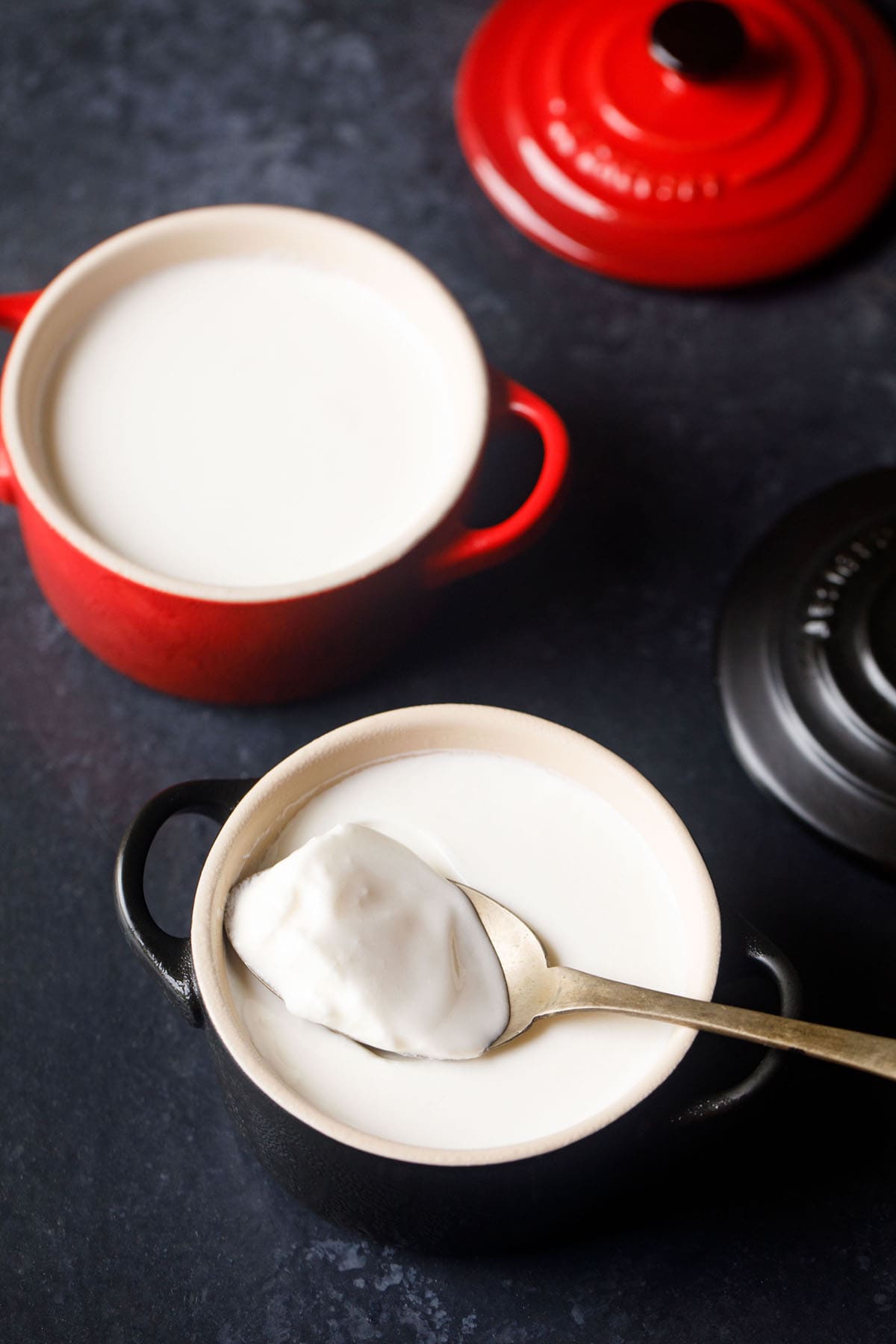
About Curd or Dahi
Curd or dahi, as it is known in Hindi, is a fermented milk product having its origins in the Indian subcontinent. The word ‘dahi’ is probably derived from the Sanskrit word ‘dadhi’ which means sour milk.
It is made by mixing a friendly bacterial yogurt starter with warm milk, which is then allowed to ferment for some hours.
Once the fermentation stage is completed, what you get is a thick, wobbly and pudding-like textured product, which the flowing milk transforms itself into.
And because there’s a fermentation process which includes bacteria, the resultant curd has a tangy taste too. Have been searching for the best answers on making curd at home, this is where your search ends!
Table of Contents
Basically, with this Dahi recipe, you get a fermented milk product that is healthy, gut friendly and probiotic in nature. This dahi can be further used to makes a variety of dishes in Indian as well as western cuisines.
The Curd Recipe yields dahi, which can also be called as the Indian Yogurt. However, know that the yogurt available outside India is quite different than the curd, of Indian origin or what is made in Indian households.
I’d been getting the most requests on sharing posts on this and even homemade paneer. While you are trying to make curd with this Dahi recipe, go for the homemade paneer with this How To Make Paneer tutorial.
I haven’t dived deep into the food science of making dahi and the fermentation process that this Curd recipe mentions. Have kept it quite basic. Understandable and doable by one and all. It also has a few tips that will help you master the art of making homemade curd.
Also, got friends who are struggling and having a tough time making fresh dahi at home? Share this post with them and make their lives easier. This Dahi recipe is quite the fool proof one that one can refer to easily.

How to make Curd
Boil Milk
1. First step is to take a thick bottomed pan and rinse it with clean water.
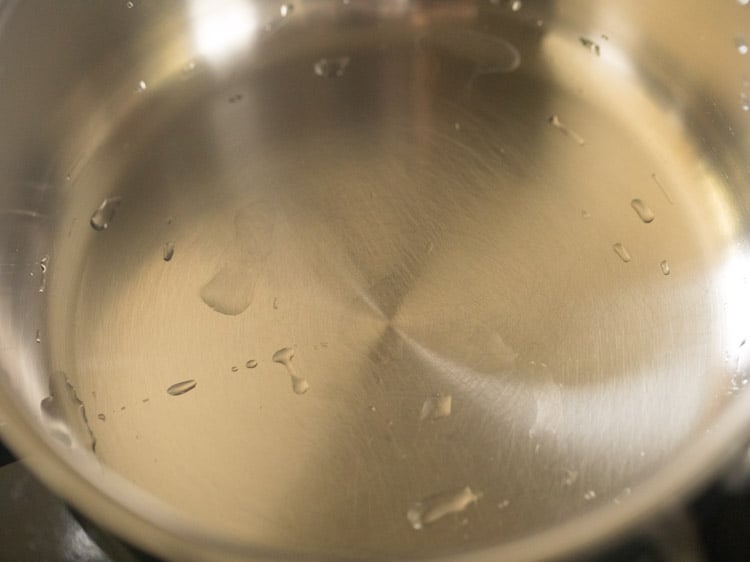
2. Then, add ½ liter (about 2 cups) whole milk. Keep the pan on the stovetop and begin to heat the milk on low to medium-low heat.
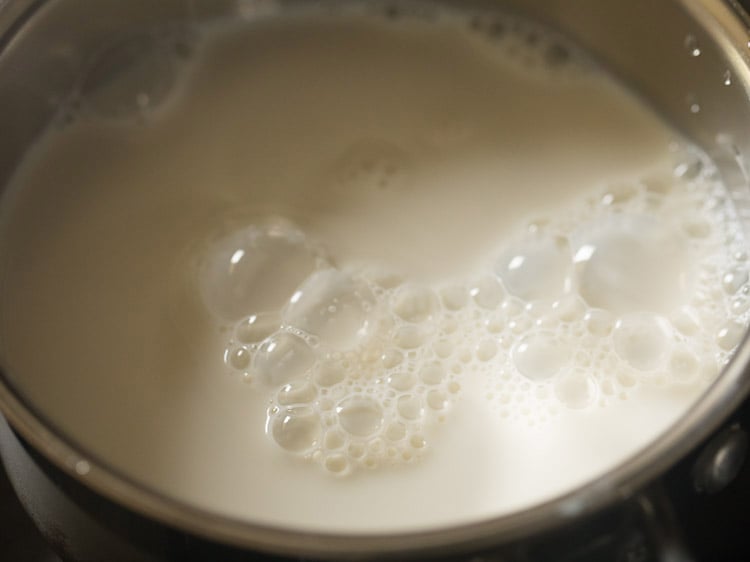
3. Stir the milk once or twice while it is heating, to avoid burning or browning from the bottom.
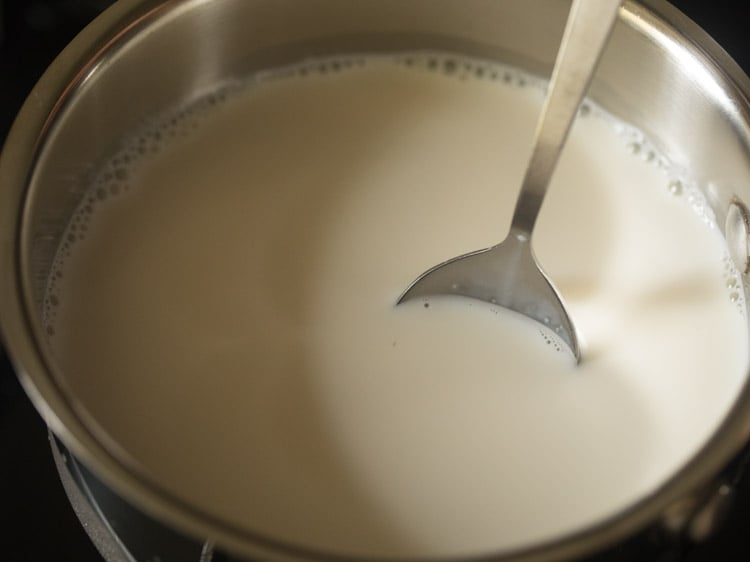
4. Let the milk come to a boil. Milk will froth and bubble when it comes to boil.
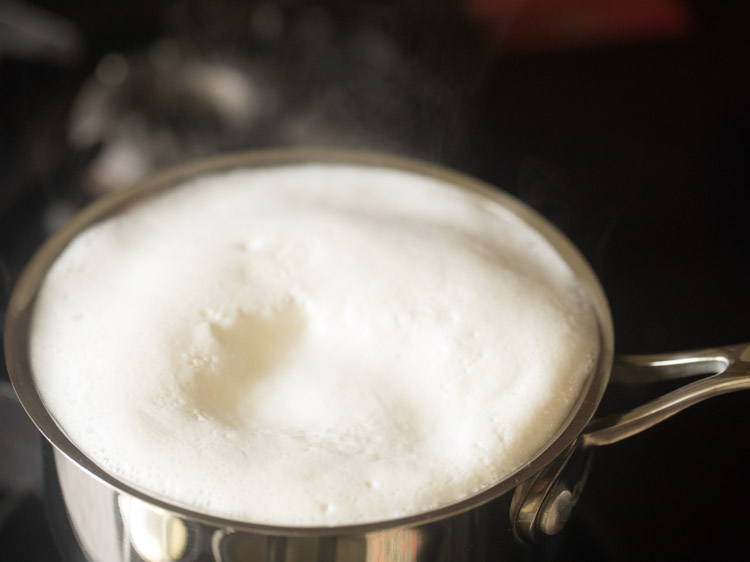
5. You can even heat milk to a temperature between 85 to 96 degrees C or 185 to 204 degrees F. If you have a food temperature scale then you can make use of it.

6. Turn off the heat. Remove the pan and keep it aside on the kitchen counter for the milk to cool to room temperature.
We only need the temperature of milk to reduce until the milk becomes warm.

Ways to check if the milk is warm
7. You can check if the milk has become warm with your fingers (touch method) or with a thermometer. Dip your little finger in the milk and you should feel warm and not hot.
Another way is to touch the pan. When you touch the pan, it should feel warm and not hot.
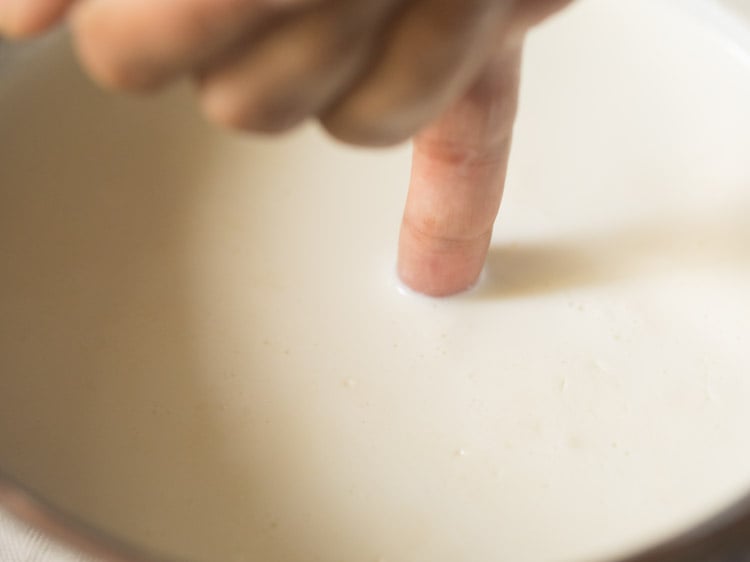
8. You can even use a food thermometer to check the temperature. The temperature of the warm milk should be between 39 to 44 degrees C or 102 to 111 degrees F.

Adding Starter
9. Now, take 1 to 2 teaspoons of the curd starter and add in the warm milk. In winters, you can add 2 teaspoons. Whereas in summers, 1 teaspoon works fine.
Here I have used a leftover curd starter. Nowadays, you also get dry starters in super markets and online stores. So you can use these package starters also.
There are many types of starters available to make different kinds of yogurt. Choose the starter for the kind of yogurt you are planning to make.
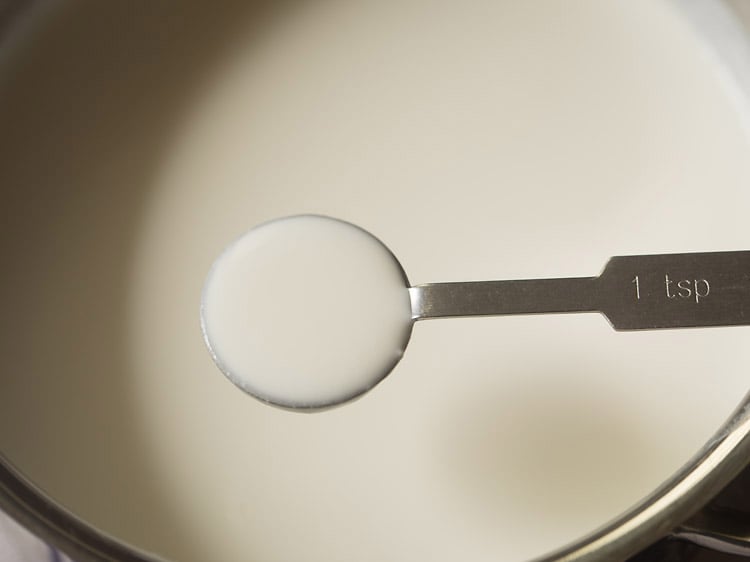
10. With a small wired whisk or a spoon mix very well. A small wired whisk makes the job of mixing the curd starter very well in the milk.

Setting Curd
11. Then, pour this mixture in a bowl or pan.

12. You can use terracotta, clay, steel, glass or ceramic bowls for setting the curd. To put less efforts, set the curd in the pan which was used to boil the milk.
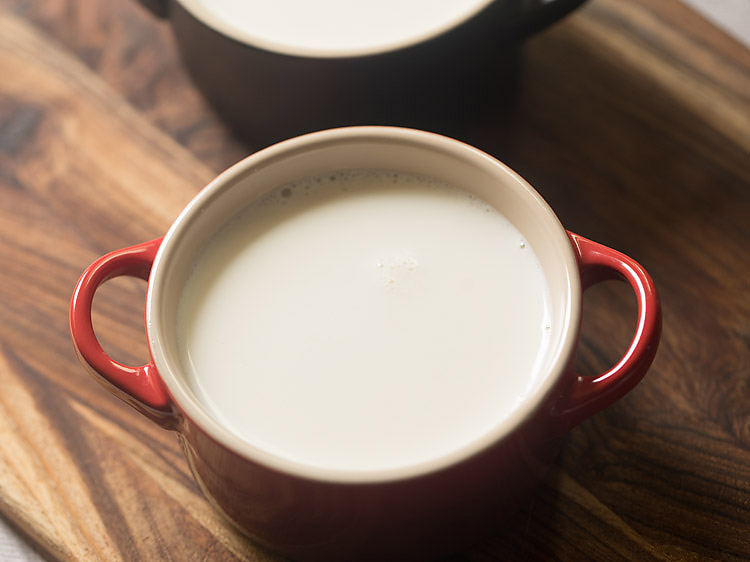
13. Cover with a lid and keep the curd to set. This is at room temperature for 4 to 5 hours. You can also keep overnight also. I kept overnight.
The time that the milk takes to convert into curd depends on the temperature. In a warm, hot and humid climate, the time taken for the curd to set will be 4 to 7 hours. Whereas in a cool or cold climate, the time taken can be 8 to 12 hours.
Nowadays, I also set the curd in the Instant Pot using the yogurt function. So if you have an Instant Pot, read the instructions to set the curd in it. Using it is very helpful if you live in a place with cold climate or during winters.

14. Next day, you will have nice well set homemade curd.
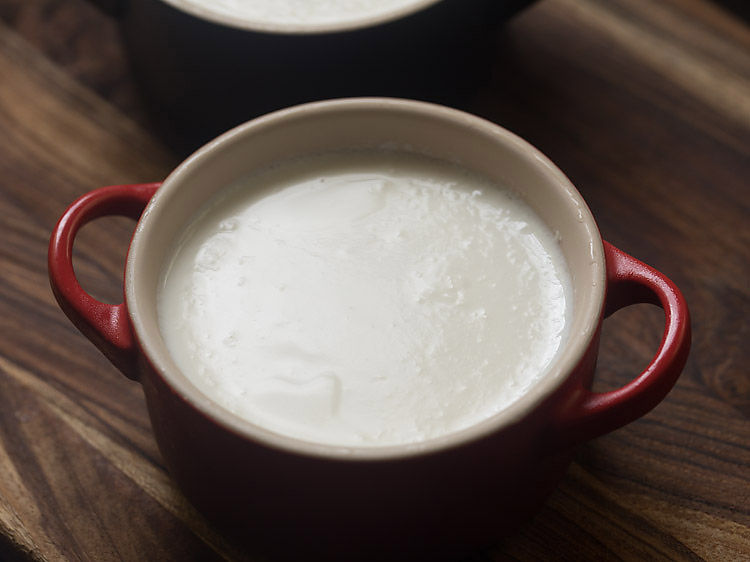
15. You can see in the below picture that its a properly set, thick and creamy curd. Usually, you see such thick curd in halwai shops (Indian sweet shops).
On fermentation, the curd will have a wobbly thick texture, pleasant fermented aroma and a slightly tangy taste. Remember to refrigerate it so that it does not get over fermented.
For any recipe, if you require sour curd, then keep it for a couple of hours more at room temperature. This will increase the sourness in the curd due to more bacterial fermentation.

Serving & Storage
Have the curd plain as is or with sugar. Use it to make desserts, beverages or any other dish. You can also have a small bowl of curd with your lunch. I have listed below the varies ways you can consume curd.
As soon as the curd is set and fermented perfectly, place it in the refrigerator. Cover the bowl or pan with lid while refrigerating. Homemade dahi keeps well in the fridge for 4 to 5 days.
Expert Tips
- Milk: To have the best results at home, use full cream or whole milk that will yield in thick, luscious, creamy curd. You could use pasteurized or homogenized milk or farm fresh raw milk. Depending on the quality of milk, you may need to add less or more of the curd starter. Note that using toned milk or low fat milk, may yield thin or watery curd.
- Heating Milk: Before beginning with the curd making process, always boil the milk. This makes sure that the milk doesn’t spoil during fermentation.
- Temperature of Milk: Don’t use very hot milk. It may coagulate and result in a grainy product. If the milk is a little hot, the curd will not be thick, is a bit runny with some whey in it. With cold milk, it will not set properly.
- Right Temperature: The milk must be just warm. Check by dipping your little finger in it. It should feel warm, and not hot.
- Mixing: Ensure that the culture is dissolved uniformly in the milk. A spoon or whisk can be used to mix well.
- Scaling: To make thick curd, use any quantity of milk. For ½ liter milk, use 1 to 2 teaspoons of culture. Increase proportionally for larger quantities.
- Storing: You must refrigerate the curd once it is set properly.
Tips to make curd in cold weather
- If you stay in a place with cold weather conditions, cover the bowl/pan of the curd mixture with a warm towel/blanket and keep in a warm place in the kitchen.
- You can also use the Instant Pot yogurt function for making curd.
- You may also place the bowl/pan in a big jar of wheat flour and cover the jar. My mother-in-law makes curd this way in the Delhi winters.
- Remember that the curd will set quicker in summers than in winters.
Uses of Curd
Generally, we have a small portion of curd with our home meals. The helpful bacteria in the curd helps to digest the food.
So, if you have indigestion issues, then you must start consuming curd in your lunch, on a regular basis. Avoid having it in dinner, as it can develop a cold in your system.
After making fresh dahi with this Curd recipe, you can use it to make a plethora of Indian snacks, mains and beverages like Chaas, Lassi, Dahi Vada, Papdi Chaat, Curd Sandwich, Curd Rice, Kadhi Pakoda and the likes.
Simple raitas can also be prepared with it and paired with your parathas, thepla, etc. With these flatbreads, you can also have plain yogurt.
This Dahi recipe will give you fresh curd which you can also use in marinades for tikka and biryani recipes. Some famous sweets that can be made with the use of Indian Yogurt are Shrikhand, Mishti Doi and Balushahi.
More How To Recipes To Try!
DIY & Collections
DIY & Collections
DIY & Collections
DIY & Collections
Please be sure to rate the recipe in the recipe card or leave a comment below if you have made it. For more vegetarian inspirations, Sign Up for my emails or follow me on Instagram, Youtube, Facebook, Pinterest or Twitter.
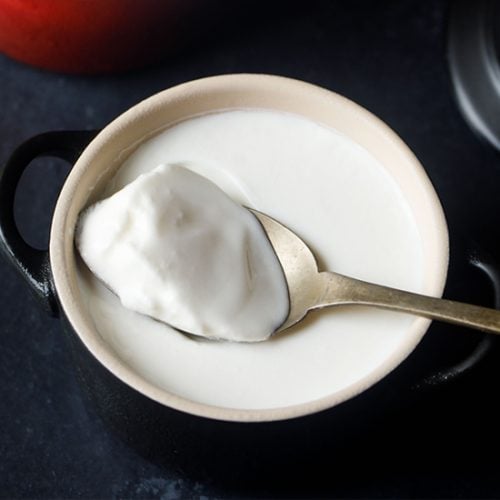
How To Make Curd | Dahi (Homemade Indian Yogurt)
Ingredients
- ½ litre whole milk
- 1 to 2 teaspoons Curd (dahi or yogurt) to be used as a starter
Instructions
Boil Milk
- Rinse a thick bottomed pan or saucepan with clean water.
- Pour milk into it and heat it on the stovetop on a medium-low to medium heat.
- Stir a couple of times when the milk is getting heated so that the milk does not get burnt from the bottom.
- When the milk comes to a boil, it will start rising. Before it spills out of the pan, switch off the heat. Set the pan aside on the kitchen countertop.
- Let the milk become warm at room temperature.
- To check if the milk has become warm dip your little finger (touch method) into the milk and you should feel warm and not hot. Second way is to touch the sides of the pan and it should feel warm and not hot.
- The third way is to check with a food thermometer and it should have a temperature between 39 to 44 degrees Celsius or 102 to 111 degree Fahrenheit.
- Once the milk has become warm, you can use the same pan for setting curd or transfer the warm milk in another bowl.
Make Curd
- Add 1 teaspoon of curd starter to the milk and mix thoroughly with a small wired whisk.
- Cover with lid and allow the milk to ferment for 5 to 6 hours or until the curd is set
- Depending on the temperature it may take more hours. You can also use Instant pot yogurt function to set the curd.
- On fermentation the curd will have a pleasant fermented aroma and with a slight tangy taste and it will also have a wobbly thick texture.
- Once the curd is made, refrigerate it so that it does not get overfermented.
- If you need sour curd for any recipe then keep the curd for a couple of hours at room temperature. This will lead to more fermentation and the curd will become sour or very sour.
- You can eat this curd with your meals. You can also add it to variety of recipes like curd rice, buttermilk, lassi, kadhi, mor kuzhambu, dahi kabab, dahi vada, dahi bhalla, biryani, paneer tikka or make raita with it.
Storage
- As soon as the curd is set and fermented well, place it in the refrigerator covered with a lid. Use a clean dry spoon to remove the curd and place the bowl or container back in the fridge.
- Homemade yogurt or dahi keeps well in the fridge for about 4 to 5 days.
Notes
- Use whole milk as it makes for a thick creamy curd.
- In hot Indian summers, this method works for me. Use pasteurized milk or raw milk that has been boiled earlier and which is refrigerated. Remove this cold milk from the fridge, mix the starter with it. Cover the bowl and let the mixture ferment for 5 to 6 hours or as needed. This saves a bit of time as you don’t need to heat the milk. But note that this method only works in a hot or warm climate. Please don’t use this method with raw milk or milk that has not been pasteurized or boiled earlier as it may have some harmful microorganisms. These microorganisms are destroyed when the milk is boiled.
- Make sure that the milk is warm before you mix the starter. Hot milk will kill the bacteria in the starter and you won’t get a properly fermented curd.
- In winters or cold climates ensure that you are not adding curd culture to milk that has cooled down. If the milk is cold, then the curd won’t set at all in the winters.
- It is very important to dissolve the curd culture uniformly in the milk. Whisk very well with a spoon or a wired whisk.
- Once the curd is set then refrigerate for a couple of days.
- To keep the starter ongoing remove a few spoons from the curd and either refrigerate or freeze it in a small covered bowl.
- If you don’t have any starter then buy packaged starters available in health stores or online stores or supermarkets.
- The recipe can be scaled. You can make a small amount or big batch according to your needs.
Nutrition Info (Approximate Values)
This Indian Yogurt Recipe from the archives was first published in May 2012. It has been updated and republished in February 2024.
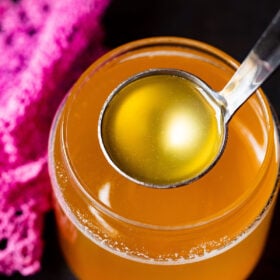
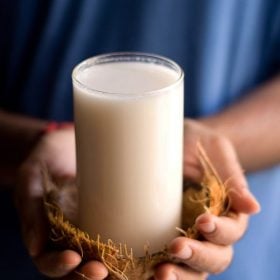

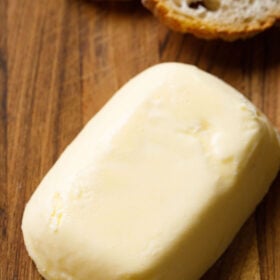

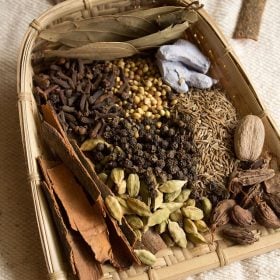









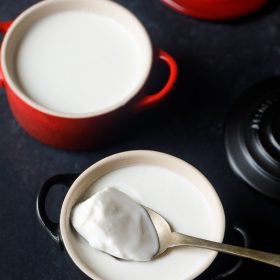
I am one of those weird people who can make pie, bread, cookies, and things that require baking in the oven but cannot make anything from normal day to day cooking. Every time I’ve tried its been an utter shameful experience and have felt like a complete failure as a cook. I’ve made yogurt twice so far using your recipe and I have restored faith in myself to say the least lol. It’s turned out absolutely delicious and sweet. I know yogurt is one of the simpler recipes but I am inspired to continue trying again. Thank you for making this recipe so easy to follow and with lovely rustic Indian photography.
thats good to know that yogurt came out well. sometimes it has happened with me also that curd has not set, specially in the cold season and i am making yogurt since ages. so its alright.
I have read the recipe for making dahi and I am still not clear as to how to make CURD? If I understand it correctly your recipe below is saying to add 1 tsp of curd to milk in order to get/make dahi.
What is curd? I though curd and dahi was one in the same?
Thank you!
curd and dahi is one and the same. and to convert a milk to curd, you need to add a small amount of curd in the milk. this curd culture or rather the friendly bacteria in the curd, converts the whole milk into curd.
I am even more confused now!!!
Why do you have to take it from neighbors or from local diary store. How can I not get it on my own. Where did the neighbors get theirs?. Did they buy it, did they make it??? If they did make it, what is the recipe for it?
ram, if you make your own curd once using the culture taken from somewhere else. then you don’t need to take curd culture from outside next time. just save 1-2 tsp of curd culture and it will be used to prepare your next batch of curd. thats how things work. there are also ways to make the curd culture with the use of green or red chillies. but i have never tried. i hope it clarifies the doubt.
I guess its a question of the chicken or the egg….anyway just in case you don’t know this trick try using half a lemon next time. You will get something close to curd and then using that you can in one or two attempts get a proper curd. That’s where the neighbours got it from 😉
thanks for the info.
haii in usa when storebrought curd is added to milk and after setting the curd while eating curd the curd is like a 1 string con sistency when taking with a spoon
mostly with store bought curd the consistency is stringy. it happens in india also at times. so i borrow the culture from my neighbours or buy the curd from halwai or dairy shops. see if you can do the same.
can curd be made without mixing curd in the milk? if so how can it be done?
kamalesh, some people make it. there is a method. but i have never tried it.
you just need to keep for a day or night, it automatically get curdled and become dahi in two days . most of the time i use this method, and it works
You can use vinegar or lemon juice to make curd instead of using curd.
Dear dassana
Ur recepies r really good.I made dahi as per ur instructions. It set good & also taste good. Please let me know the recipe for black paper urad dal papad.my kids like it.I want to give them home made papad without any preservatives.please please let mi know this recipe.
thanks ajita. i don’t have a ready recipe. i need to try. so if i try the recipe i will surely add in the blog.
Hi dear,
no worries..my doubts are cleared. I have tried exactly u have guided in ur recipe and my dahi turned out well! Now then I now that dahi can be made without even churning them!! Hahaha!
Thank u a lot sweetheart…
welcome simirthy 🙂
Hi dear,
before I leave my doubts behind, I would like to let u know something.
U’re really AWESOME!!
Really!
I have learnt plenty of things from ur site and they are fully informative with reasonings!
One of ur recipe that made me famous is ur Panneer butter masala! And now all my cousin calls me with that name hehehehe..
I can also boast to other non-veg eating people that look at the amount of dishes and things we can prepare at home, making them alter their thoughts of that vegetarian is boring! I hate to hear that from people!
I’m just 26 but I have learnt many cookings and partially credit goes to people like u for inspiring me!
Thanks a million!
Looking at ur homemade dahi recipe, I have a small doubt. Do I need to churn the milk after adding dahi into the warm milk? Or do i just add the dahi into the warm milk and leave it aside after giving a stir?
thanks a lot simirthy for the inspiring words. i have seen both your comments. so the problem is solved 🙂
I warmed up the milk then I added the curd. I put a sweater around the milk. The house got 62 degrees. The milk did not turn into curds. Should I worm up the milk on the stove again?
I did read your instructions today morning. I warmed up the milk at Knight. the temperature outside is 34 degrees and 60 at knight at home at knight.
sam, if the curd does not get set overnight then you have to discard the milk. its not safe to drink this milk. because the milk becomes sour. the curd didn’t set because of low temperature. for next time, if you have a oven.. then keep the oven lights on and keep curd bowl inside. just keep the oven lights on and don’t heat the oven.
I like your site very much…….coz it makes cooking easy
Thanks a lot mam
🙂
welcome ravinder. glad to know this.
Can you please tell me which pot you use for making curd. As in metal or earthen ware
i use steel bowl or pan to set curd.
Very good site.
The easy language and pictures used for representations for simple dishes make your site very nice. Great work.
thanks sonam. glad to read your positive feedback.
Here is a tip.. You can put warm milk into a casserole after mixing the culture… As it will help milk to stay warm and curd will set faster. I set curd by this trick and get thick curd within two hours.
thanks prabhjit for sharing this tip. this tip works very well in cold seasons. my mil does the same way in winters.
hi jus want to let u know its very easy & only takes 5 min & 25 rs & u get half kg of dhai which u dont get stores the same measure of dhai costs u around not less than 50 rs 😉
thanks daniel for the feedback and sharing your views. i agree with you.
nice..
Hi! I love your page (: such lovely food! I’m from Denmark. I cant wait to make my own yogurt. If I use goats milk, can I still use live yogurt from cow to mix in ?
yes you can.